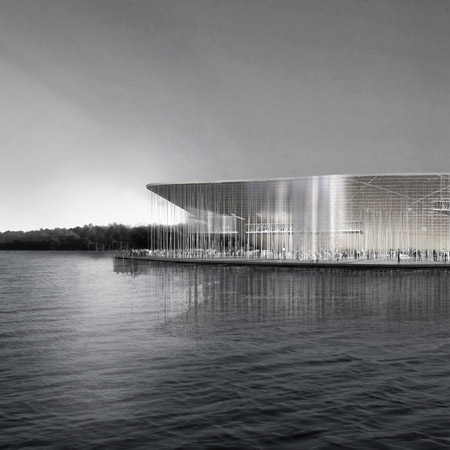
Portsmouth FC stadium by Herzog & de Meuron
Architects Herzog & de Meuron have unveiled revised plans for a football stadium on the waterfront at Porstmouth in England.
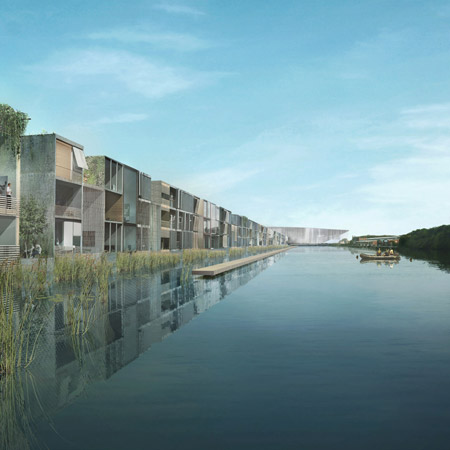
The proposal, for Horsea Island in Portsmouth harbour, replaces an earlier design for a stadium located in the city centre. See our story from last year for details of the original proposal.
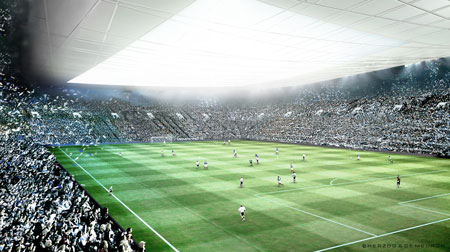
Herzog & de Meuron's scheme includes a new 36,000 seater stadium for Portsmouth FC, an exhibition centre, housing and a waterfront park.
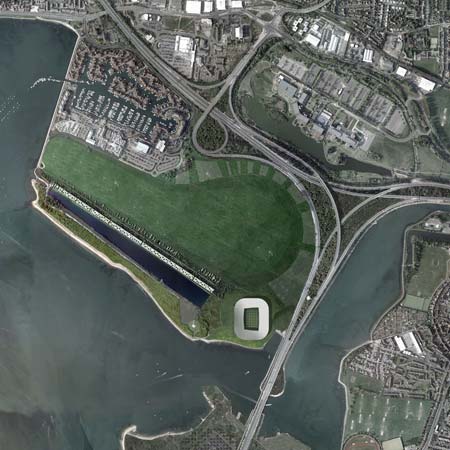
Below is a statement from the architects followed by a press release from the developer, Sellar Property Group:
--
A Stadium on the Water, Football in the Park, an Icon for the City
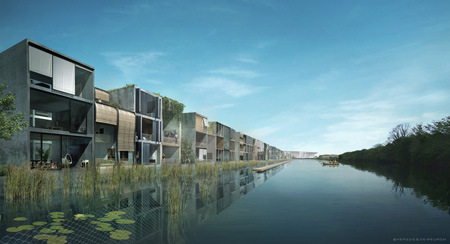
Portsmouth’s historical asset has traditionally been its connection with the water, and more recently football has become the other great asset of the city. Horsea Island will allow the football stadium to become a visual icon at the gateway to the city, creating a new identity for both Portsmouth and Pompey. It is perfectly situated on the water next to the confluence of the main access roads, allowing a dramatic first view of the stadium with the city behind.

Since the 15th century Portsmouth has been the main navel port of England. The Navy is still an integral part of the city and so it is fitting that they have been pivotal in enabling Horsea Island to be developed and provide the city with a new stadium. They currently own and occupy the land surrounding the former torpedo range on the island and have offered to release the northern and western edges for the stadium and enabling development in return for a new Navy dive school. This would involve a phased approach to allow the diving operations to continue during construction of the new facility on the southern edge of the range.
While the majority of the island is a former landfill site, which limits development, it is however an opportunity to create a new public urban park on the water, a green centre to a variety of new developments including the stadium that will activate Horsea Island and ‘stitch’ the quality of the park with its immediate surroundings. The site is recognised as being rich in biodiversity, and of particular interest are the Brent Geese that currently use the site to nest and rest. To foster and encourage this use two green corridors are provided connecting the new urban park with the water.
The stadium will be a pavilion in the new urban park, the new pitch a clearing in the trees. Slender tree-like structure is used to support floating program pavilions surrounding the bowl with veil like transparency with a simple drape of structure supporting a lightweight roof. The space underneath the bowl functions like a grand foyer, still exterior, but sheltered from the elements. During the game the focus is on the match. Before, after and during half time the focus is outwards towards the park, water and unobstructed views of the city.
Located at the edge of the city and close to both local and national motorway connections, Horsea Island offers unique opportunities to generate quality urban development in addition to the stadium to include residential, retail, a multi-purpose arena, as well as the new urban park.
Located between the former Torpedo Range Water body and the new Horsea Urban Park, each residential unit has the opportunity to be connected to both the water and the park. The overall length of development is punctuated with public amenities, and the depth and height of the built unit is limited to ensure both interior and exterior spaces can always be naturally lit.
A sustainable energy approach for the whole island will take advantage of the different program elements to work together and ensure a low carbon emission scheme.
ARUP are a key partner providing invaluable insight and support into structural, environmental, infrastructure, maritime, microclimatic and sustainability aspects of the project. Vogt landscape architects provide specialist insight into species, arrangement and concept to ensure the new urban park, the residential development and especially the stadium are all seamlessly integrated as a whole landscape element.
Herzog & de Meuron, 2008
--
PORTSMOUTH FC AND SELLAR PROPERTY GROUP JOINT VENTURE TO CREATE STUNNING WATERFRONT STADIUM AND REGIONAL EXHIBITION CENTRE/ARENA ON GATEWAY SITE TO CITY
Portsmouth Football Club (“Pompey”) and Sellar Property Group (“Sellar”) today unveil plans for a stunning waterfront stadium.
The development is being designed by Swiss-based leading international architects, Herzog & de Meuron. The firm is responsible for both the Beijing National Stadium, centrepiece of this year’s Beijing Olympics, and the Allianz Arena football stadium in Munich.
Pompey’s new stadium is planned on a ‘gateway site’ to the city on the south side of Horsea Island, adjacent to the M275 and M27 motorway junction overlooking the Harbour, Naval Dockyards and out to the Solent.
The project, together with future redevelopment of Fratton Park (Pompey’s existing ground), will generate several thousand jobs during the construction period and many hundreds of permanent jobs post completion.
The waterfront development will create a superb 36,000 all-seater stadium and a stand-alone major regional multi-use indoor exhibition centre/arena capable of promoting major concerts, exhibitions and indoor sporting events with an all-seater capacity of 10,000.
In addition, a new Naval diving and training facility is planned. This will be supported by a mixture of complementary low-rise residential, retail and leisure uses.
Pompey and Sellar also announce proposals for the redevelopment of the club’s historic 17-acre Fratton Park site for a mix of low-rise residential and retail uses.
A phased development of Fratton Park will create a low-rise scheme in keeping with its environment. Part of the site, including the current car park and adjacent land, will be developed while the club continues to play at Fratton Park.
The club and Sellar have formed a joint venture company in which both Fratton Park and the new waterfront development will be held, enabling appropriate development finance to be secured to complete the overall project. The creation of the residential and commercial elements of both schemes will contribute to the development.
Subject to receipt of the necessary consents, work could get underway in 2009 and construction of the new stadium the following year.
Peter Storrie, Chief Executive of Pompey, said: “We only have one word to describe this stadium. Perfection. The club will be playing a big part in the regeneration of the city and our fans will have the very best in terms of facilities and amenities as well as an excellent viewing experience.
“Portsmouth Football Club has moved into a new era with the backing of owner Alexandre Gaydamak and these are very exciting times for the club both on and off the field. The new stadium, along with plans for the club’s new training ground at the Alver Valley in Gosport are proof of where we want Pompey to be – playing at the highest level and in a stadium befitting a top Premier League side.”
James Sellar, Chief Executive of Sellar, said: “‘Cutting edge’ solutions to stadia require an owner who personally identifies with the project and is willing to embrace a scheme within a masterplan, which is outside of the ‘accepted rules of technique’. Our challenge is to deliver a solution that coordinates the needs for user comfort, sustainable access and cost effectiveness while keeping input of materials and energy to run the facility as low as possible. We are delighted to be working with Alexandre Gaydamak in deep confidence and believe this would be an extraordinary collaboration in an era where the Club is going through rapid change. Quality of experience is all important.”
David Williams, Chief Executive of Portsmouth City Council said: "I think the plans for the new stadium and arena are very exciting, and the stadium in that location would look stunning. I really do hope that satisfactory solutions to accessing the site can be achieved and I look forward to seeing proposals for this.
“The club and their developer partners are aware of concerns about the location and impact of so much shopping, both at Port Solent and Fratton, which could be damaging to the rest of the city – this will need to be assessed. Also, the proposed concentration of all the affordable housing in one location conflicts with current policy.
“However, whilst it will be for the planning committee to determine the application, the City Council will continue to do its utmost to help the club produce a workable and acceptable scheme to achieve a fitting new stadium for the FA Cup holders."
Commodore David Steel, Portsmouth Naval Base Commander, said: "The Royal Navy is delighted to be working with Portsmouth City Council and other authorities to find a solution that will allow the Football Club to build its exciting new stadium.
“I am sure that all Service personnel in Portsmouth recognise that the club derserves a fabulous new home in this unique maritime city of such tremendous potential .”
Supporters will be encouraged to use all forms of transport: bus, car, and park-and-ride, pedestrian and train services. To that end a comprehensive package of transport measures aimed at providing efficient access to all the facilities on Horsea Island will be introduced.